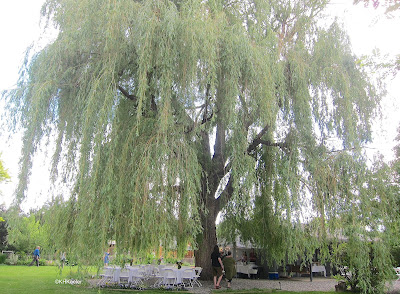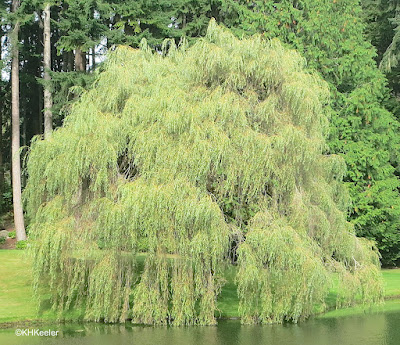(Psalm 137,
King James Bible translation)
Not only was it thought to be from that area, they pointed to its sympathetic, weeping shape as supporting the story. Nevertheless, weeping willows are from China and the tree of the Bible verse was probably the Euphrates poplar (Populus euphratica).
 |
| a really big weeping willow, Boulder Co., Colorado |
Weeping willows are dioecious, with "male" trees producing pollen and no seeds, and "female" trees producing seeds but no pollen. In various regions, especially along the Silk Road, all the trees were cloned from a single introduction, so are all female or all male. Weeping willows clone easily, facilitating that; fresh branches quickly root if stuck into moist soil. The pieces of willow my mother used to mark rows in the garden of that rented house frequently put out leaves by fall!
Willows are a world-wide genus of some 400 species. Only a few of them weep, that is, have pendulous branches like the one we call the weeping willow. Weeping willow was long ago spread all over the globe. Today a few other weeping species of willow are sometimes sold commercially.
Weeping willow (Salix babylonica) was probably more commonly planted in the U.S. in the past than currently, because they get very big (30-50' high, 35' wide), are messy, dropping twigs everywhere, and become hollow so that big branches are torn off by storms. Add to that that that they generally live only about 70 years, and you see why they are better suited for growing by a pasture pond than in a small suburban yard.
 |
Weeping willow in formal Chinese garden, Suzhou, China
|
Very popular in China, you see weeping willows in formal gardens and along canals and waterways. It was a symbol of spring, light, and vitality, since it turned yellow and then leafed out early in the year. Slender, supple, and fragile, weeping willows represent beautiful women in Chinese literature and art, since at least the Tang Dynasty (618-907CE). On the other hand, willow was a Chinese euphemistm for prostitution. In another inconsistent use, the interwoven branches suggested attachment, and were given to a friend at parting. It had power to protect a place or person from demons. Growing best close to water, weeping willows were important in ceremonies to bring rain. It was a well-known plant rich in folklore.
 |
weeping willows along a river in China
|
European willow folklore did not generally mean weeping willows, since the weeping willow was such a late-comer to Europe. Once there, though, it was included in existing willow lore, for example to attract a lover or protect from harm. The Bible verse associated it with sorrow and exile throughout Christian Europe. That may have been the origin of the phrase "wearing the willow," which seems to have meant both sorrowing for an unfaithful or unrequited love and grieving for the loss or absence of a loved one, which are really quite different.
 |
weeping willow branches
|
Willows, weeping willow included, are readily woven into baskets. The wood is soft but forms big pieces and can be carved into useful items. There is a long medical tradition of chewing willow bark for pain, but that was from the white willow, Salix alba, of Europe, much more than from the weeping willow.
This time of year, I particularly notice willows, weeping willow included, because their leafless branches, high in the air, turn yellow as spring approaches. It is an important sign of spring for me.
 |
| Mid February: the yellow of the willow anticipates spring. |
Comments and corrections welcome.
References
The Bible. King James Version. BibleGateway.com
. link Accessed 2/23/22.
Cunningham, S. 1983. Cunningham's Encyclopedia of Magical Herbs. Llewellyn Publications, St. Paul, Minnesota.
Drori, J. 2018. Around the World in 80 Trees. Lawrence King Publishing. London.
Oglivie, M. 2019.
Massive weeping willow has cost Beach homeowners thousands in repairs, but they wouldn’t have it any other way. Toronto Star.
link Accessed 2/23/22.
Oxford English Dictionary online. Willow. Accessed 3/1/2022.
Missouri Plant Finder.
Salix babylonica. Missouri Botanic Garden.
link. Accessed 3/1/22.
Valder, P. 1999. Garden Plants of China. Timber Press. Portland, Oregon.






No comments:
Post a Comment